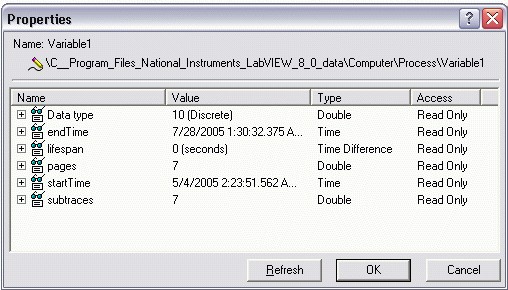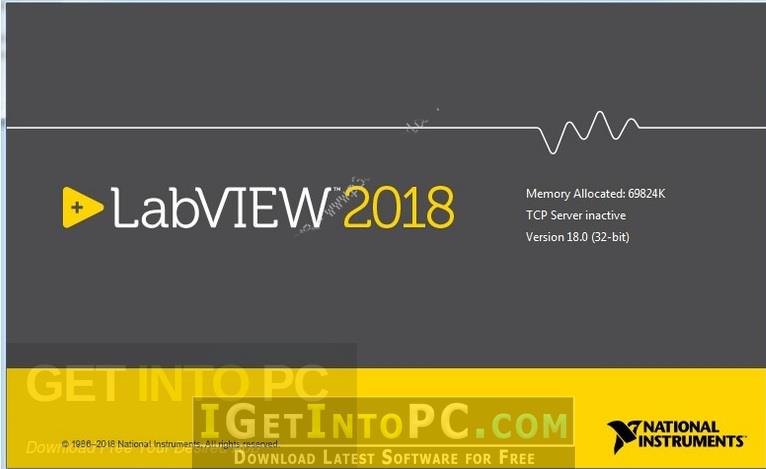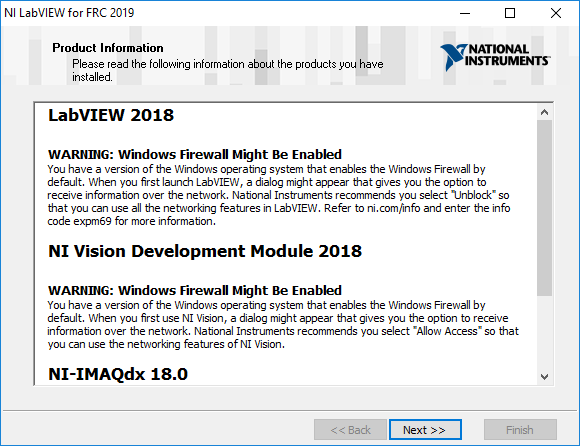It’s another year and National Instruments has released LabVIEW 2017. This guide will walk you through the steps for downloading and installing the product.
LabVIEW 2017 System Requirements
First, you’ll want to make sure your computer can run LabVIEW 2017. Refer to the below table to see the system requirements:
The LabVIEW 2017 Platform Known Issues contains a full listing of known issues, including LabVIEW Development System and modules. Refer to the Third Party Licensing & Activation Toolkit group on the NI Community website for questions or information about any known issues in the Third Party Licensing & Activation Toolkit. National Instruments offers a collection of add-on modules and toolkits for LabWindows/CVI, which can help you in particular application areas. Add-on modules and toolkits are additional libraries or utilities developed to meet the specific needs of specialized markets, industries, and application areas. From LabVIEW 2013 to 2016, the LabVIEW DSC module contains an API for programmatically communicating with and exchanging data between OPC UA servers and clients. Starting with LabVIEW 2017, OPC UA Toolkit was released separately from the LabVIEW DSC Module and became a stand-alone LabVIEW toolkit. The first time I installed Labview and the myRIO toolkit stuff, it worked fine. Then, later it keeps saying it is missing modules. I have tried uninstalling everything and reinstalling many times in slightly different ways and updating everything in slightly different ways in case I was getting the order wrong. Currently I am trying to connect myRIO to Labview 2017. I have installed everything. With the NI LabVIEW Third Party Licensing & Activation Toolkit, you can add licensing and activation features to your LabVIEW VIs and applications built with LabVIEW. This reduces the amount of effort required to develop ad hoc licensing solutions and offers you an integrated and consistent process for activating your third-party LabVIEW. On the download page, scroll down to the “NI LabVIEW 2017 Downloads” section. All the links will be listed there. Notice all the modules under the “Additional Toolkit Downloads” section.
It’s another year and National Instruments has released LabVIEW 2017. This guide will walk you through the steps for downloading and installing the product. LabVIEW 2017 System Requirements. First, you’ll want to make sure your computer can run LabVIEW 2017. Refer to the below table to see the system requirements.
| Windows | Run-Time Engine | Development Environment |
| Processor1 | Pentium 4M/Celeron 866 MHz (or equivalent) or later (32-bit) Pentium 4 G1 (or equivalent) or later (64-bit) | Pentium 4M (or equivalent) or later (32-bit) Pentium 4 G1 (or equivalent) or later (64-bit) |
| RAM | 256 MB | 1 GB |
| Screen Resolution | 1024 x 768 pixels | 1024 x 768 pixels |
| Operating System | Windows 10/8.12/7 SP13 Windows Server 2012 R22 Windows Server 2008 R2 SP13 | Windows 10/8.12/7 SP13 Windows Server 2012 R22 Windows Server 2008 R2 SP13 |
| Disk Space | 620 MB | 5 GB (includes default drivers) |
| Color Palette | N/A | LabVIEW and the LabVIEW Help contain 16-bit color graphics. LabVIEW requires a minimum color palette setting of 16-bit color. |
| Temporary Files Directory | N/A | LabVIEW uses a directory for storing temporary files. NI recommends that you have several megabytes of disk space available for this temporary directory. |
| Adobe Reader | N/A | You must have Adobe Reader installed to search PDF versions of all LabVIEW manuals. |
| 1 LabVIEW and LabVIEW Run-Time Engine require processors of the Pentium 4M/G1 generation or later, which are capable of executing SSE2 instructions. 2 NI software installs VC2015 Runtime and .NET 4.6.2. Windows 8.1 and Windows Server 2012 R2 require Microsoft updates to support these items. Refer to Microsoft KB2919442 and KB2919355 for more information about how to install these updates. 3 NI software is signed with a SHA-256 certificate. Windows 7 SP1, Windows Embedded Standard 7 SP1, and Windows Server 2008 R2 SP1 require Microsoft updates to support SHA-256. Refer to Microsoft KB3033929 for more information about how to install this security update. | ||
Overall, these requirements are not high. If you have a computer that was made in the last 5-8 years, you should be fine. Regardless, it’s important to verify your hardware to be sure you can run the software before purchasing it.
Downloading the Software
You can download the software from this page. Scroll down to the “NI LabVIEW 2017 Downloads” section and click on the link for the version you need. Chances are, if your computer was made in the last 6-7 years, you will want to download the 64-bit version.
When you click on one of the links, you’ll be brought to NI’s website. You’ll see two options listed. Click the link that says “I am a current user of LabView Development System”. NOTE: If you do not see these options, you may need to login to the website by using the Login option at the top-right of the page.
Ni Labview 2017 2b Tool Kits And Modules Free
Once you click on the link, you’ll be asked what your current version of LabView is. Choose “LabView 2016” from the dropdown.
Click “Continue” once you’ve selected LabVIEW 2016 from the dropdown.
Now, you’ll be on the download page. You can click the Blue link that says “Download LabVIEW 32-bit for Windows” or you can click the link further below that says “LabVIEW for 64-bit Systems” if you want the 64-bit version.
Once the download is done, navigate to where your downloads are and right-click the newly downloaded file and click “Run as Administrator”.

Upon clicking “Run as Administrator”, a window will come up, asking you where to save the installer. Leave the settings default and click “Save”.
At this point, the download manager will begin downloading the installer. Your window will look like this:
How long the download takes depends on your internet connection. If you have slow internet, this could take a while.
Once the download is done, you’ll see an “Open” option show up on the download manager. Click this option.
The Installation Procedure
After clicking “Open” on the Download Manager, a window will come up asking you to extract some data. Click “OK” on this window.
Another window will come up, asking you where to extract the files to. Usually, the default file path is fine. If, for some reason, you need to save it to a different location, then you can click the “Browse” option and choose a different file path. Click “Unzip” to begin the extraction.
The files will begin extracting. How long this takes depends on your computer hardware. This process can take anywhere between several seconds to several minutes. Be patient.
Once the files are done extracting, a window will come up, telling you the files have been extracted. Click OK.
At this point, the installer will open itself up. If you don’t see the installer, look at your taskbar across the bottom of your screen and click on the Computer Monitor icon, as seen here:
Once the installer is open, click “Next”. The installer should have opened by itself after the previous step.
On the next window, fill out your name and organization and click “Next”. NOTE: This information is information pertaining to YOU. Do not just copy the information from the below screenshot.
Next, you will be asked for your product serial #. If you purchased a digital copy from us, you will have been sent your serial #. It will look something like this: B01P23456.
If you purchased a physical copy, then the serial # should be located somewhere on the packaging. Typically, it is attached to a sticker on the sleeve the DVD came in. If you don’t see it there, thoroughly check your package for a serial #. If you do not have a serial #, contact us, and let us know and we’ll do our best to resolve your issue.
In the “LabVIEW 2017 (Base/Full/Professional)” section, put your serial # into the white box. If you received serial #’s for the other products listed, put those numbers into their appropriate boxes.
Ni Labview 2017 2b Tool Kits And Modules Pdf
The next window will ask you where you want to install the software to. Leave these options default and click “Next”.
On the next window, you will be asked which features you wish to install. Click the drop-down arrow next to the “NI Device Drivers” option and choose “Do Not Install Device Drivers”. We do this because this installer does not include these drivers. If you have a MyDAQ, you will want to download the drivers separately.
On the next window, leave the check box checked and click “Next”.
The installer will search for updates. Usually, it will tell you there were no updates found. Click “Next”.
Next, you will be asked to agree to some license agreements. Choose the “Agree” option and click next.

Next window will ask something similar. Choose to accept and click “Next”.
On the next window, I recommend unchecking the box to prevent Windows fast startup. I have never had an issue arise from Windows fast startup being enabled. None of our customers have ever had an issue either.
Now, you will be shown a review of what you will be installing. Click “next” to begin installation.

The software will begin to install. How long this takes depends on your computer hardware. It could take a few minutes to a few hours, depending on your hardware. Be patient.
Once the installation is complete, click the “Next” button
You will then be asked if you want the software to periodically check for updates. This is up to you. Generally, it’s recommended to choose “yes” so you can keep up-to-date with your product.
You will then be asked to restart your computer. I highly recommend restarting immediately instead of waiting until later.
Licensing: Activate Your Software
Once your computer restarts, we need to activate the software
Go to your start menu and type “NI License Manager”. Click on the “NI License Manager” application.
Once the wizard is open, click the “Activate software” button at the top of the window.
In the box for “LabVIEW 2017 Student Edition”, put in your serial #.
The wizard will contact NI’s servers and attempt to activate. If all goes well, it should tell you the activation was successful. You can now close out of the license manager.
Opening LabVIEW
Now that the software is installed and activated, you’re ready to use it. You should have an icon on your desktop for LabVIEW 2017. If you do not have this icon, then open your start menu and type “labview 2017”. The LabVIEW 2017 application should show up. Click on this application to open it. You can also right-click on the application and choose “Pin to Taskbar” if you want to create a shortcut on your taskbar across the bottom of your screen.
Once the program is open, you are good to go!
Ni Labview 2017 2b Tool Kits And Modules 5th
Support
Ni Labview 2017 2b Tool Kits And Modules For Sale
If you purchased LabVIEW 2017 from Studica and you are running into issues with this process, you can contact our support by filling out a ticket. We will contact you as soon as we can to try and resolve your issue.